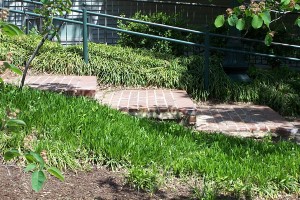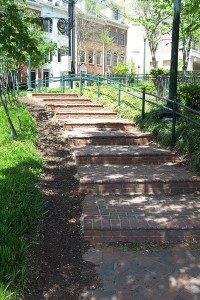Pedestrians can have it hard enough getting from place to place, building access to the wrong dimensions shouldn’t exacerbate the problem.
The set of steps I used to take from the Metro/Marc station in Silver Spring – from 2nd Ave up to Fidler Lane, next to the McDonalds – are a prime example of bad design. The details of such things shouldn’t be overlooked: you can’t build steps to fit grade, you need to fit human scale. Well, you can, but then you haven’t designed anything, you’ve conceded to expediency.

Steps should follow a simple couple of rules: twice the riser height plus the tread should equal about 26 inches; landings should match this stride length – but slightly less so.
These particular steps have 7 inch (+/-) risers and 42 inch treads.

It would have been better to tighten up the steps and have a few 12 inch steps with longer landings at regular intervals or do the complicated 6 inch riser with the odd half-step we take at the top of steps, which is about 18 inches – making about a 32 inch tread. But this is difficult to average – and not comfortable for most people.
Generally, stick with something we are comfortable with: 6-7 inch risers and 12-14 inch treads or broader 4 inch risers with 18 inch treads.
GK
Stairs are one of the most gracious elements in all of architecture and when they are wrong, they are bad, as you note.
There are no hard and fast rules, but the one you mention is about as close one can get. If a steps introduce an awkward gait, they are wrong.
Also outdoors a set of steps, even with appropriately dimensioned treads, feels too steep if the riser is above 6″. 7″ feels fine indoors.
One great loss is the entry steps to civic buildings or the monumental stairs. Probably due to the laziness of dealing with the mandated ramps, these are increasingly eschewed unless grade change demands it.
Woodsider
And don’t forge that it’s nearly never acceptable to have just one step because it is a major tripping hazzard. In most cases, the 6″ – 7″ of rise from the step could have been spread out over the surrounding ‘run”.
Eric
I had to do an entire project on step heights for one of my Urban Studies classes at UPenn. It was called Power of Place and was my first experience looking at planning and development directly from a person’s experience on the ground. It’s a fantastically useful point of view.